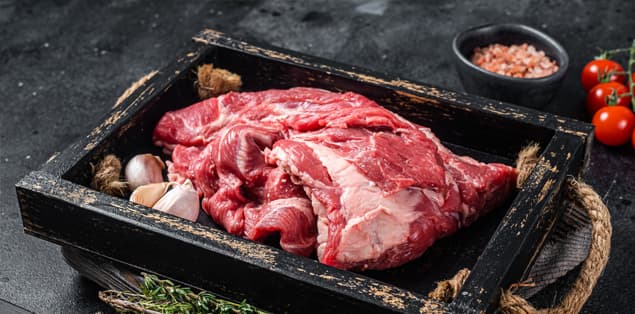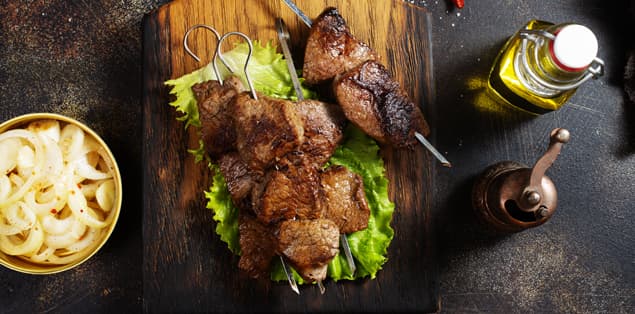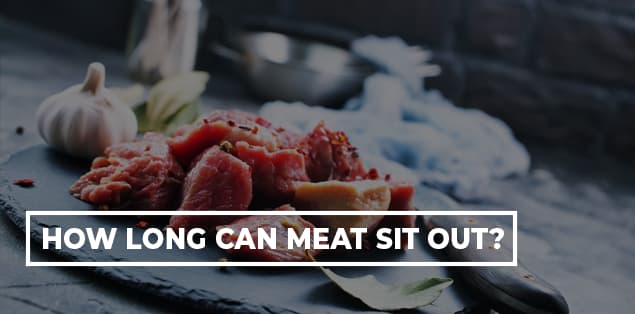Meat is just the sort of food that we all know must be handled with care when preparing and storing it to ensure its safety for consumption. Knowing how long meat can be left out is difficult because meat could be raw, cooked, frozen, or refrigerated. Many people believe that these changes will affect the amount of time meat can sit at the normal room temperature. In this article, we’ll discuss how long can meat sit out?
How Long Can Raw Meat Sit Out?

Raw meats that have you leave out for longer than they ought to are frequently linked to foodborne diseases. The US Department of Agriculture warns people against thawing raw meat at room temperature because it provides an excellent habitat for bacteria to grow.
In general, one should not leave raw meat in temperatures exceeding 40 degrees Fahrenheit for more than two hours in any case. If this limit exceeds, it becomes a place where bacteria can grow rapidly.
If you’re wondering if you can consume uncooked beef and uncooked ground meat after 2 days, then the answer to your question is a no.
How Long Can Cooked Meat Sit Out?

Listeria, E. coli, and Salmonella are just a few germs you find on meat. Eating meat containing these germs will result in an extremely unpleasant foodborne illness, which no one wants to contract.
If you leave a cooked steak in the refrigerator for 3 to 4 days, it will still be safe to eat.
The best approach to avoiding bacteria-related diseases is to ensure that the meat is prepared correctly. This process includes not leaving it out of the refrigerator for an extended period, as this is when bacteria begin to multiply. The temperature on counters is ideal for bacteria development, causing them to nearly double in number in just 20 minutes.
How Long Can You Leave Cooked Chicken Out?
It makes no difference whether the chicken is cooked or raw when it comes to spoilage. You only can keep it in the fridge for a specific time before it spoils.
When this happens, the food is no longer fine to consume or cook with.
It’s not a good idea to leave the chicken out for more than 2 hours. As a general rule, if cooked or uncooked meat has been left out at room temperature for more than 2 hours, it should be discarded.
If the temperature in the room or surroundings is 90 degrees or more, the chicken should only be left out for 1 hour.
How Long Can Deli Meat Sit Out?

Cold cuts, sliced deli meats, cooked foods, and cut vegetables that have been left out at room temperature for 2 hours or longer (or one hour above 90° F) are harmful, according to the US Department of Agriculture.
- Pre-packaged Deli Meats last for 7-10 Days
- Bologna lasts for 1-2 Weeks
- Salami (hard)* lasts for 3-4 Weeks
How Long Can Frozen Meat Sit Out?

The United States Department of Agriculture recommends that frozen meat must not be left out for more than two hours. Harmful bacteria begin to develop and reproduce as soon as any meat component hits 40 degrees F, posing a danger of foodborne diseases and cross-contamination. Pre-cooked and raw frozen meats are both affected.
Meat can be prepared from frozen materials but not in the slow cooker, increasing the cooking process by half. Defrost the meat before cooking it as an alternative.
How Long Can Hamburger Meat Sit Out?
If the hamburger remains at room temperature for more than 2 hours, you should throw it, just like most cooked meats. Otherwise, it could be harmful to your health. To ensure optimal food safety, refrigerate all leftovers as soon as possible, and package them tightly.
After you’ve finished cooking the hamburger, you have 2 options. You may either find a means to keep it at 140 degrees or make sure to refrigerate it within two hours. Because keeping the meat in a “hot zone” can cause it to dry up, it’s best to keep an eye on the clock and put any leftovers away as quickly as possible.
How Long Can Meat Sit Out to Thaw?
The USDA recommends that one should never leave food out in the open longer than two hours or one hour in areas with an air temperature above 90 degrees Fahrenheit. If one wants to thaw overnight, leaving it in the fridge is better. Meat kept at room temperature between 40 and 140 degrees Fahrenheit for an extended period can quickly develop bacteria (such as Salmonella Enteritidis, Escherichia coli, and staphylococcus aureus).
How Long Can Charcuterie Meat Sit Out?

Regardless of the season, charcuterie platters have become a popular way to serve delectable cuisine to visitors at get-togethers, parties, and lunches. The charcuterie boards come from cured meats, and people serve them with cheese, crackers, olives, almonds, spread, and fruits. It is fair to say that its popularity has risen in recent years, and it is designed to provide a variety of sweet and savory options to everything.
Even if there are cured meats such as chorizo, prosciutto, soppressata, and salami, the FDA recommends only leaving a charcuterie board out for two hours.
If you leave the food out at room temperature for more than two hours, bacteria will form on the meat, potentially making your visitors sick. In truth, these two hours include the time it takes for the meat to come to room temperature. Nonetheless, meat is not the only component of a charcuterie board; you must also consider cheese. This is because holding the cheese at room temperature allows the flavor to develop.
Four hours on the charcuterie board is plenty when it comes to cheese.
How Long Can Meat Sauce Sit Out?

You should toss out cooked meat sauce sitting out for more than 2 hours. If you expect to eat it within a few days, both handmade and store-bought beef sauce can be refrigerated after being left out for two hours.
On the other hand, you can normally store canned and unopened beef sauce at room temperature for up to 2 years!
If your can of beef sauce has a real expiration date, denoted on the label by the letters EXP or Expiration Date, you must discard the can even if it is unused once that date has passed.
How Long Can Smoked Meat Sit Out?
You have 4 days to devour the remaining roast that now your Texas-style beef is secure in the fridge and properly kept. Otherwise, substances that trigger food poisoning may be present. Even though fridge temperatures are maintained below 40 degrees Fahrenheit, which is outside the Danger Zone, bacteria continue to grow over time.
You can only leave the smoked meat out for 2 hours if you don’t have a heating plate or a technique to maintain it above 140°F. Otherwise, bacteria that cause serious sickness will increase on the surface of the meat—hence, proper food handling necessitates keeping food at safe temperatures.
You can quickly warm smoking meat in a slow cooker or even on the stove. Microwaves heat smoking meat, but they don’t heat food evenly, leaving some of it in the USDA Food Safety Danger Zone temperature.
How Long Can Turkey Meat Sit Out?
To preserve the turkey, break it into tiny pieces of about 2 to 3 inches so that it cools rapidly. Then, place it in a tight container. Leftovers can be kept for up to four days in the refrigerator or frozen for up to two months and reheated to 165 degrees Fahrenheit before consumption.
Final Words
You must discard food that has been kept between 5 and 60 degrees Fahrenheit for more than 4 hours. While you may not always fall sick if you eat food left out overnight, you should not eat meat that has been left out of the fridge for more than two hours, according to the USDA.
Bacteria grow rapidly at room temperature and can make you sick at dangerous levels. It is not safe to reheat something sitting at a certain temperature range for more than two hours as one cannot see or smell bacterial contamination.
The maximum you should keep perishable foods at room temperature is not over two hours (one hour at temperatures 90 degrees F and higher).
If these food items are left at room temperature overnight, they might not be safe to consume. Perishable food includes dairy products, raw ground beef, ground meats, etc.
